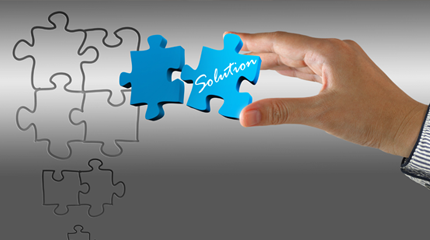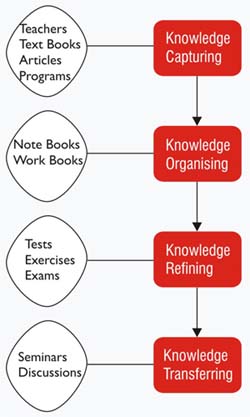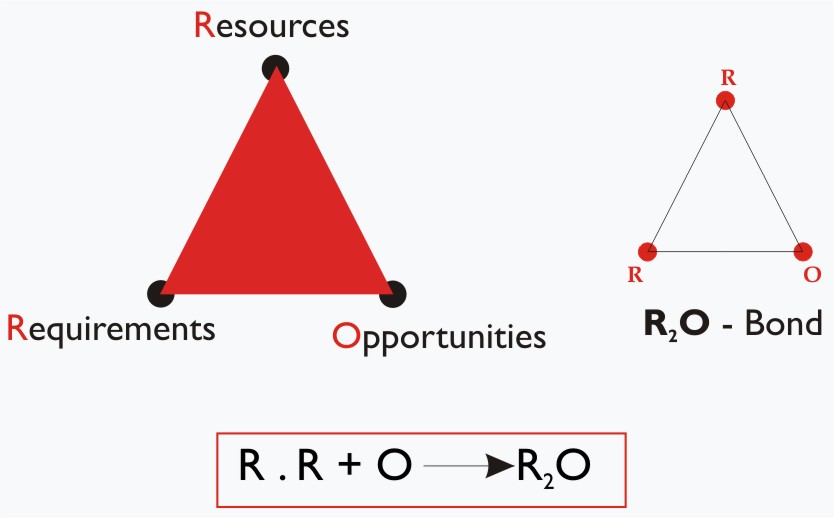
M O M A Process
Getting motivated by situations, events or by the actions of others is a human trait. There must be always a purpose or reason behind every action or activity of human beings. By nature, human beings are intellectual beings, i.e., they can think, understand and respond to any requests and alerts. Motivation is the mother of objectives. It comes from some intrinsic or extrinsic values and it may help develop a great hope for tomorrow. Motivation also keeps us going even in times of crisis. Wise persons set themselves certain objectives as a result of motivation. To achieve objectives, a firm commitment to purpose is of utmost importance. This commitment helps people realize their goals.
In general, some make industrious efforts to fulfill their objectives within a set deadline. Some others fail to do so despite enormous efforts. The reason for this difference is management. The achievers ‘manage’ to take relevant decisions. The losers lack clarity of purpose and they often tend to take erroneous decisions to their disadvantage. Therefore, 'management skills' are also imperative to achieve any objective.
It so happens that even high scoring students fail to achieve even minor objectives because of poor 'management skills', while in some instances, even average students 'manage' to achieve their major objectives by virtue of their 'management skills'.
It is clear that there is a strong interrela-tionship between Motivation, Objective, Management and Achievement.
Eduranet has done extensive research on this interesting aspect and discovered this interrelationship between these four variables. The resultant findings have paved the way for the invention of an innovative learning process, christened by Eduranet as 'MOMA' learning process. This learning process consists of certain steps that are to be taken to sustain motivation and achieve ultimate goals.

Eduranet has devised this process for the benefit of all standards of learners and professionals as well. This also helps students solve their real life problems as well with increased confidence.
MOMA Learning Process:
'MOMA’ is a self-oriented process of learning, which guides learners in achieving their objectives. It is a self-motivating mode of learning. ‘MOMA’, in fact, is the backbone of the entire Eduranet Education System. This is a unique learning process by which the followers of the process motivate themselves after fixing objectives and achieve them with inspiration from the great deeds of individuals worldwide.
This process is applicable to any kind of learners irrespective of their geographical backgrounds.
‘MOMA’ consists of the following four aspects:
1. Motivation - M
2. Objective - O
3. Management - M
4. Achievement - A
1. Motivation
Psychology defines motivation as the driving force behind all actions of all creatures. Motivation is based on emotions, specifically, on the search for positive emotional experiences. For example, a mother can motivate her children by citing instances of the achievements of some of her persons known to her or celebrities.
The self-control of motivation is a subset of emotional intelligence. For instance, a person may be highly intelligent according to a more conservative definition (as measured by many intelligence tests), yet unmotivated to dedicate this intelligence to certain tasks. Eduranet's MOMA learning process has proved to be effective in correcting this intellectual imbalance.
(a) Modern Theory of Concrete Learning (Motivation Theory)
One of the greatest virtues of human beings is their ability to think and act accordingly. Inquisitiveness and aspiration to come out with the best have been the pillars for man’s quest for development. The quest comes from self-motivation.
- You know that creative thinking is at once an art & a strength. Creative learners are more successful than casual ones.
- Determination propels creativity to further your interests.
- Creativity & determination are the two arms of a successive learner.
- Determination adds value to your strength.
- Hard work strengthens your two arms of creativity & determination. It is the secret of one's strength & success.
- Deriving satisfaction from what one has already achieved is a major weakness of learners. This attitude dents our talent.
- Build a concrete objective for your learning. Ask yourself “What am I learning? , Why am I learning?”. These questions develop your learning objectives.
- Aspirations such as “I must be the best of the lot”, “I must be the superior” help us determine our goals. If you don't set goals, you will end up as a rudderless boat.
2. Objective
An objective can be defined as an expected achievement or desired result that is specific, measurable and derived from set goal(s).
In terms of education, learning objectives, behavioural objectives, instructional objectives, or performance objectives are terms that are used to make judgments about student learning.
Learners must fix objectives for his motivation. The purpose of learning influences a learner's objective. Whether he/she is preparing for some subject, doing revision of the subject, planning to write any test, and working on assignments or doing practical work, each of these tasks can be termed as objectives.
3. Management
Once a learner motivates himself/ herself and fixes some objective(s), the next step he/she has to follow is to manage his learning priorities properly. Management (of learning priorities or preferences) plays a major role in MOMA learning process.
In this context, management involves application of different learning strategies. They include scheduling suitable strategy and collecting inputs for learning. This management skill helps learners follow a relevant learning mode without waste of time and energy.
The following are different kinds of management systems that have been incorporated in ‘MOMA’ learning process:
a) Knowledge Management
b) Learning Management
c) Resource Management
a) Knowledge Management:
Knowledge management is a multi-disciplined approach to achieving objectives by making the best use of knowledge in the learning process. In knowledge management, a learner captures /gathers, organizes, transfers/shares, and refines/analyzes his/her knowledge in terms of understanding and recalling.
1. Knowledge Capturing - Teachers, Books, Articles, Programmes.
2. Knowledge Organizing - Note Books, Papers, Work Books, Assignments.
3. Knowledge Refining -Tests, Assessments, Exercises, Exams.
4. Knowledge Transferring - Discussions, Seminars, Sharing with others.

1) Knowledge Capturing: It is a process by which a learner captures knowledge by listening to what others say in the form of lessons by teachers or lectures by experts. A learner also captures knowledge by reading books, material and newspapers or magazines; watching television or movies; browsing internet, attending seminars and watching different programmes. One also gains knowledge by observing the examples of others or by doing experiments.
2) Knowledge Organizing/Codifying: It is a procedure by which knowledge is stored and codified for effective use. A learner organizes knowledge using notebooks, work books or assignments to present it later in a class room or a test. There are several other ways to organize knowledge. For example, facts can be presented by graphics, tables or by just statements.
3) Knowledge Refining: It is a procedure by which knowledge is put to test to assess the understanding levels and to clear ambiguity. The basic motivation of testing knowledge is to control performance, efficiency, quality of the knowledge base. Tests, exercises and exams are the commonly used knowledge refining types. The goal of every learner is successful application of his/her knowledge.
4) Knowledge Transferring: Once knowedge is captured, organized/ codified, refined / tested and applied, the next step is to demonstrate how it is transferred to the right party in the right format and at the right time. Knowledge transfer implies sharing and exchanging of knowledge.
b) Learning Management (LM)
Learning management, under Eduranet Education System, is an act, manner, or practice of managing; handling, supervision, or control of Knowledge (K) of every learner with respect to Time (T).
Eduranet has discovered a strong correlation between Knowledge (K) and Time (T) in the calculation of the learning efficiency of a learner. To assess a learner's capability / performance we need to test his/her Comprehension (Co.), Application(Ap.), Analysis (An.), Synthesis(Sy.) and Evaluation(Ev.) of relevant knowledge.
According to Eduranet Education System:
K x Concentration (Con.)= Comprehension
K x Implementation(Imp.) = Application
K x Fact-finding(Ff.) = Analysis
K x Creativity(Cre.) = Synthesis
K x Judgment(Jud.) = Evaluation
Where K = Knowledge
Therefore, knowledge (K) is common factor in all these five variables.
Eduranet believes that Education is the addition of Comprehension(Co.), Application(Ap.), Analysis(An.), Synthesis(Sy.) and Evaluation(Ev.) of Knowledge(K).
Education(E) = Con. +Ap. + An. + Sy. + Ev.
E = [K x Con.] + [K x Imp.] + [K x Ff.] + [K x Cre.] + [K x Jud. ]
E = K x {Con. + Imp. + Ff. + Cre. + Jud.}
X = Con. + Imp. + Ff. + Cre. + Jud.
E = K x {X}
In fact, Education (E) is a progressive acquisition of knowledge (K) over a specific span of time (T).
Therefore:
E = K {X} / T
Where,
E - Education
K - Knowledge
T - Time
X-Concentration+Implementation+Fact-finding + Creativity + Judgment

Knowledge(K) & Time(T) graph.
Learning Management System (LMS)
The Eduranet-LMS has been developed to manage time and resources effectively in the learning process. It is a comprehensive combination of different planners like course planner, lesson planner and topic-wise planner etc,. The life cycle of LMS starts with the preparation of subject material, followed by revision, assignments and evaluation. The following method has been proved to be effective in ensuring quality of the learning process.
Define, Measure, Analyse, Improve, and Control (DMAIC)‘DMAIC' stands for:
1. Define Learning - D
2. Measure Learning - M
3. Analyse Learning - A
4. Improve Learning - I
5. Control Learning - C
1) Define Learning: It will be useful to the learners if they define learning objectives like the purpose of learning i.e., Preparation/ revision/test/ assignment.
The date of learning, start and end time of learning and the names of lesson and topic are to be mentioned in the relevant planner. Once a learner completes study of a lesson, he/she has to make notes on the knowledge/ understanding levels of that particular lesson. He/she is also required to note the recall level of the lesson and doubts, if any, in the planner.
2) Measure Learning: In this second stage, learners are required to self-assess or measure their knowledge of a particular subject or situation. For this purpose, they can seek assistance from others like teachers or colleagues. This process helps learners to have a perfect understanding of the subjects they learn and clear doubts, if any, through knowledgeable sources.
3) Analyse Learning: In this stage, learners are required to analyse the difficulties they face while learning a particular subject or situation. The reasons for poor performance manifest in this stage. Learners can take the assistance of others to analyse their performance. They have to prepare efficiency graphs (Knowledge and Time) in each subject or lesson to gauge their understanding levels and analyse the reasons for their failure to comprehend a particular subject.
4) Improve Learning: In this stage, learners are required to seek solutions to problems they face while understanding a particular subject by accepting suggestions from others like teachers or colleagues. This helps improve their understanding levels and performance.
5) Control Learning: Control is necessary in any system for continuity. Likewise, a learning process also needs control. Educational or other institutions have the responsibility to adhere to the four different stages of 'DMAIC' process to sustain quality in learning.
c) Resource Management with R2O-Bond:
In our daily life we have to fulfill different types of requirements for our comfort. We can't fulfill our requirements, unless we have relevant resources. Although we have plenty of natural resources, we have to depend on man-made resources.
Everyone has to put in serious efforts to develop these resources. It is necessary that we assess the quantity of our requirements and decide ways to generate resources to fulfill them. Also a clear idea about opportunities (the sources which offer resources) is required to balance our resources. Eduranet has discovered a strong bond between Requirements, Resources and Opportunities. The R2O-Bond.

Figure R2O-Bond.
Economic growth of an individual or an institution or a country happens in different stages. In every stage, we have to fulfill certain requirements to sustain growth. Education (learning), food, clothes, shelter etc, are the essential requirements of an individual. Parents, teachers, knowledge, experience etc., are the examples of an individual's resources. Water, air, crude oil etc., are natural resources. If one doesn't have sufficient resources to fulfill his/her requirements then he/she has to give an opportunity to others. Jobs, all raw food items, means of transport, educational institutions etc., come under the head of 'Opportunities'.
NOTE - Don't confuse resource with opportunity. For example, you need a house to reside. This is your requirement. If you have your own house, it is a resource for you. If you live in a rented accommodation, this is to be referred to as an opportunity created by the owner of your house. For the house owner, you are a resource to generate his income. In the industrial world, IT Enabled Services like outsourcing are opportunities created by other companies. A call center is a good example of this.
There are two types of R2O -Bond:
1. Strong R2O -Bond
2. Weak R2O -Bond
If the ratio of Resources, Requirements and Opportunities is the same or balanced, that R2O -Bond is called a Strong R2O -Bond. This type of a bond makes a country , institution or an individual very strong and developed.
If the ratio of Resources, Requirements and Opportunities is not the same or is im-balanced, that R2O -Bond is called a weak R2O -Bond. This type of a bond makes a country, institution or an individual weak and underdeveloped.
This R2O-Bond is as important as H2O-Bond. H2O-Bond saves human life, while R2O-Bond saves human economy.
4. Achievement:
Achievements are something accomplished successfully. At the end of a learning session every learner wants to know what he/she has gained after putting in all efforts. Learners must ensure that they achieve good results as an outcome of their hard work.
The Learning Process course has been designed exclusively for the benefit of the students and salaried class to improve their performance levels and help them reach new heights in their careers.